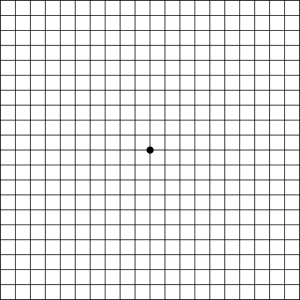Age-related macular degeneration, or AMD, is a gradual deterioration of the macula – a small part of the retina’s light sensitive tissue – which is responsible for clear, detailed vision.
Age-related macular degeneration affects your central field of vision and makes it hard to see details clearly. Age-related macular degeneration is painless but central vision will gradually appear distorted, blurry, or blind spotsmay develop.
It is important to note that there are two types of age-related macular degeneration, “wet” and “dry”. This page covers the wet prognosis and treatment of age-related macular degeneration. Click here to read about the dry age-related macular degeneration.
Please note, this page covers the “wet” form of age-related macular degeneration (wet AMD)
The wet form of age-related macular degeneration is a more advanced and serious retinal condition. Wet macular degeneration is characterized by the growth of abnormal blood vessels underneath the macula.
These blood vessels cause swelling and bleeding in the macula causing a distortion of vision. For patients with the wet form of age-related macular degeneration, straight lines will appear wavy and blind spots may appear.
Eventually, these abnormal blood vessels will scar, leading to a permanent loss of central vision.
Symptoms of Wet Age-Related Macular Degeneration
The wet form of age-related macular degeneration has few symptoms at early stages, which is why regular eye exams are important. As the macula gradually deteriorates, straight lines will begin to appear wavy or distorted.
In the wet form, vision loss happens quickly and is more severe.
Common symptoms associated with the wet form of age-related macular degeneration include:
- Straight lines may appear distorted, curved, or wavy
- Increased difficulty seeing fine details. For example, reading small print, writing, and watching television
- The centre field of vision may appear distorted or blurry
- Reduced ability to perceive and distinguish between colours
- Appearance of blind spots
For most patients, the symptoms of age-related macular degeneration usually occur in both eyes but it is possible for changes to affect only one eye.
Causes of Wet Age-Related Macular Degeneration
Age-related macular degeneration is one of the leading causes of vision loss among adults.
The main factors that put you at greater risk of developing age-related macular degeneration include:
- Over the age of 60 years old
- Family history of age-related macular degeneration
- History of smoking
- History of high blood pressure
- High cholesterol or obesity
- More common among women than men
- More common among Caucasians
Diagnosing Wet Age-Related Macular Degeneration
Age-related macular degeneration can be detected during a dilated eye exam by your eye care professional.
A basic test that may also be used is for the patient to look at an Amsler grid. An example of an Amsler grid is included below.

This grid is outlined like a chess / checker board with vertical and horizontal lines. If any of the lines appear wavy, missing, or if blind spots appear, this may be a sign that you have macular degeneration.
If the presence of age-related macular degeneration is detected, your ophthalmologist or retinal specialist will likely recommend a fluorescein angiogram test. This test is to view the blood vessels within your eye and identify any leaking blood vessels that could be causing further damage to your eyesight. This test is vital for the wet form of age-related macular degeneration.
Treatment ofWet Age-Related Macular Degeneration
Treating the wet form of age-related macular degeneration will slow the progression of vision loss – and in some cases, regain vision that was previously lost – but there is currently no cure. The earlier that age-related macular degeneration is identified, the better the patient’s chance of maintaining healthy eyesight.
Given the increased severity and risk of vision loss for wet cases of age-related macular degeneration, receiving prompt treatment from a retinal specialist is crucial.
There is a range of treatment options available for wet cases of age-related macular degeneration, all of which are performed by Calgary Retina Consultants on an outpatient basis. Patients are able to return home immediately after treatment.
Brief summaries of the most common treatments are outlined below. Please click upon the name to be redirected to a page with a complete description of treatment and recovery.
Avastin, Lucentis or Eylea Injections: Avastin, Lucentis, and Eylea are intravitreal injected anti-VEGF medications. These medications block the chemical responsible for the growth of abnormal blood vessels under the macula. By slowing the growth of these blood vessels, Avastin, Lucentis, and Eylea help mitigate the risk of vision loss caused by fluids leaking from the vessels. One of the key advantages of Eylea is the predictability of scheduled injections and monitoring. For patients, this means less time is spent each month for receiving treatment.
Photodynamic Therapy: Also known as PDT, photodynamic therapy is a treatment for wet age-related macular degeneration. During this treatment, a light-sensitive drug is injected into the bloodstream; this collects in the abnormal blood vessels that have formed underneath the macula as a result of wet age-related macular degeneration. A laser is then used on the eye to activate the light-sensitive drug, this, in turn, creates blood clots in order to block the abnormal blood vessels and leaking fluids.
For all patients diagnosed with age-related macular degeneration, even for those undergoing treatment, you are recommended to check your vision daily and to notify your retinal specialist if there are any noticeable changes in your vision.